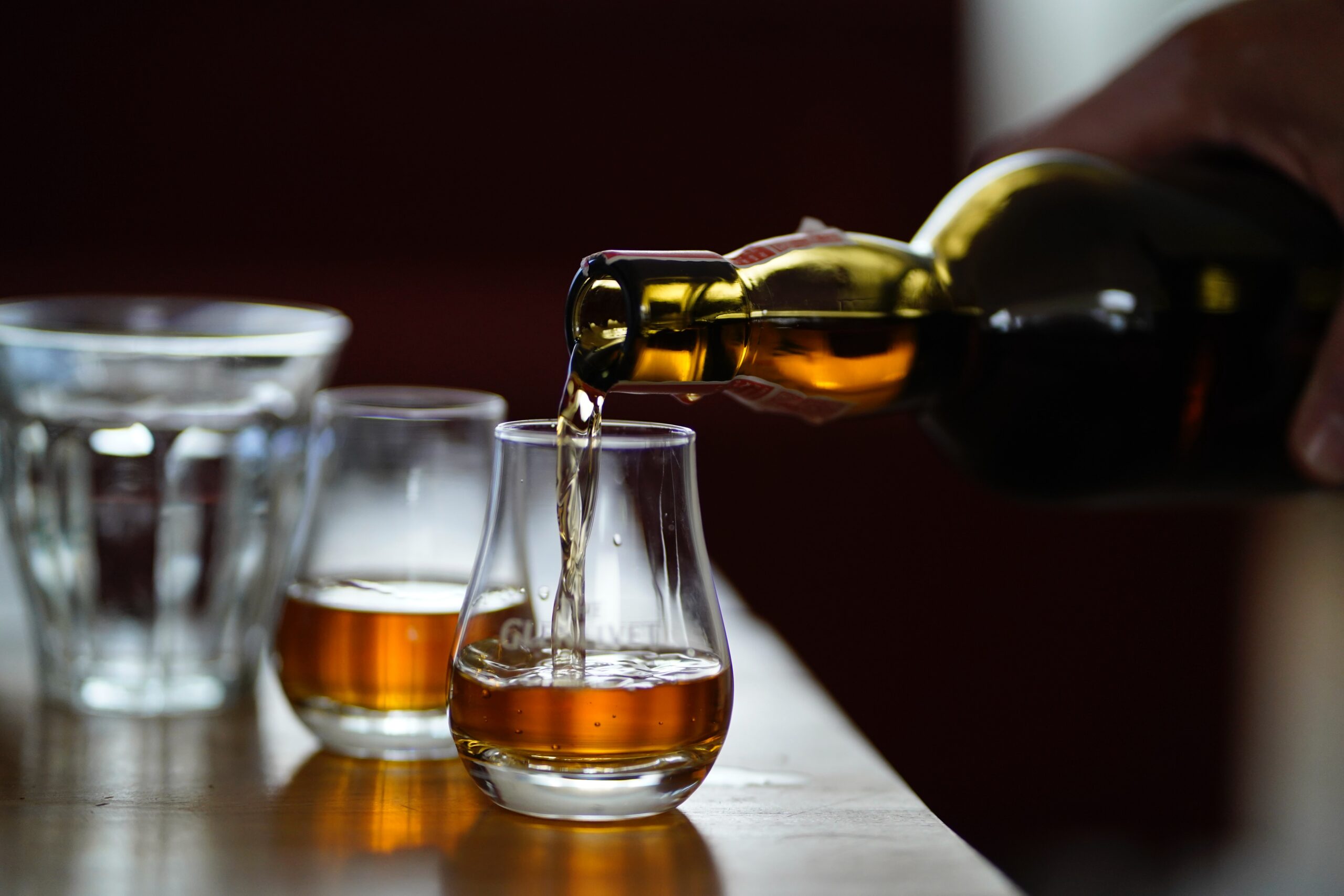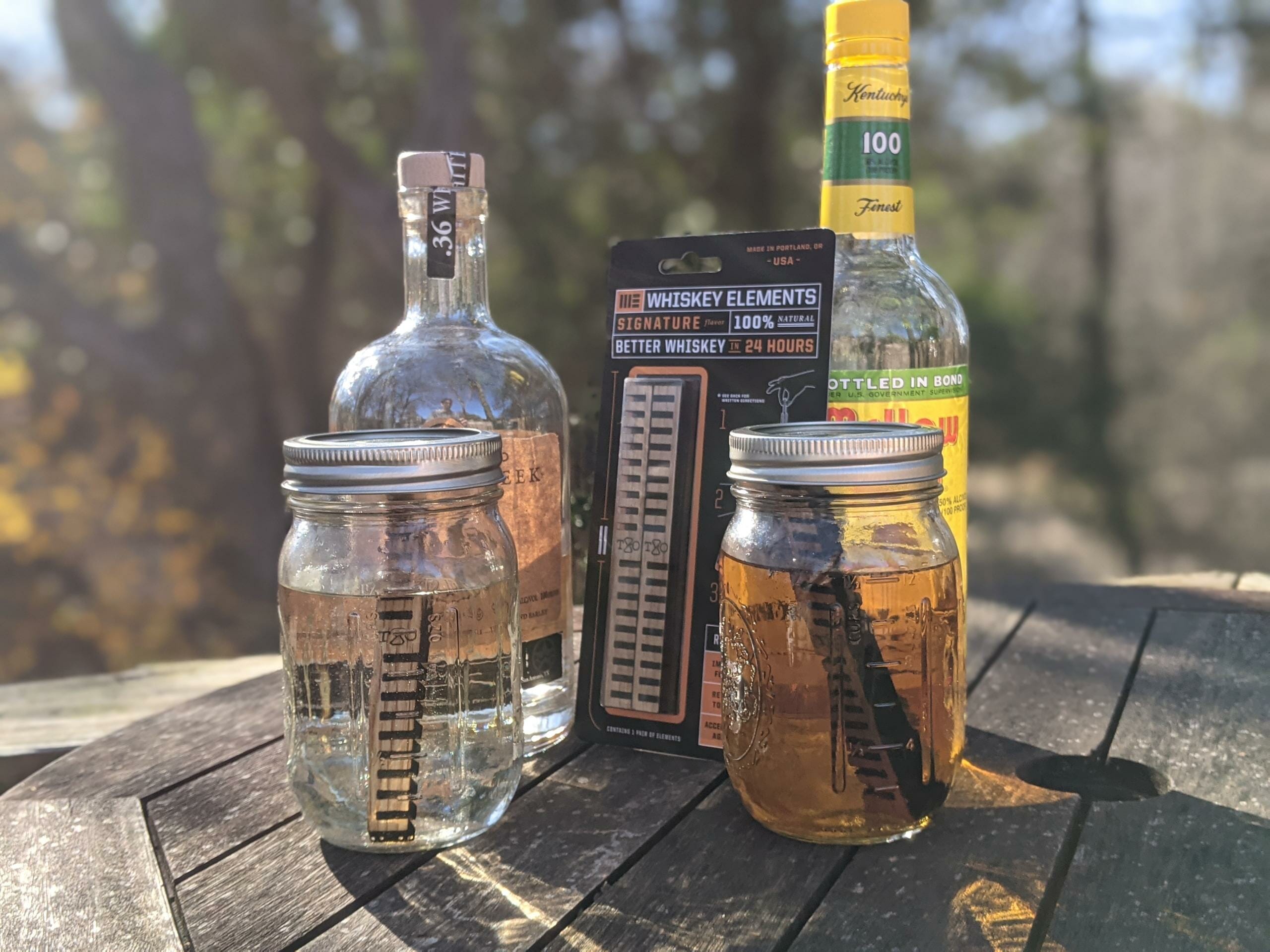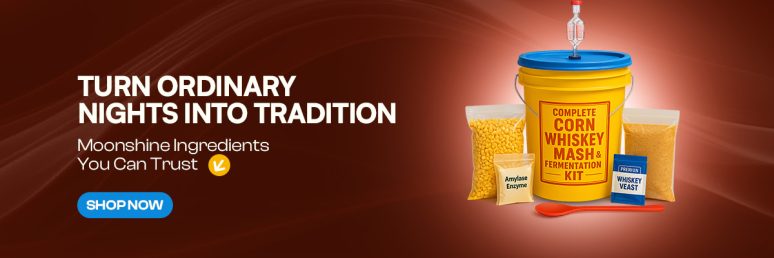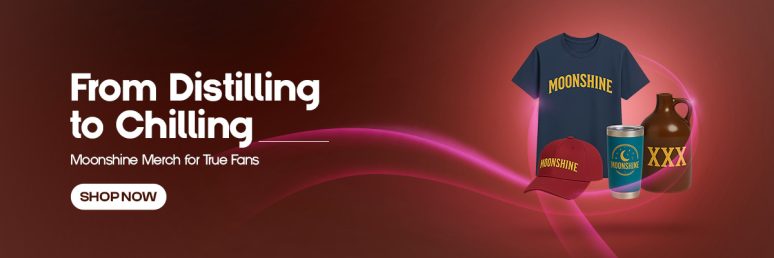What Is the Difference Between Spirits and Moonshine: Beginner’s Guide

Key Takeaways
- Spirits are legally produced alcoholic beverages made through distillation, while moonshine traditionally refers to illegally distilled liquor made without government oversight.
- Commercial spirits typically range from 35-50% alcohol (70-100 proof), whereas traditional moonshine can reach dangerous levels of 80-90% alcohol (160-180 proof).
- The aging process is a key difference—many commercial spirits are aged in wooden barrels to develop flavor, while moonshine is typically unaged.
- Legal “moonshine” products sold today are actually regulated spirits marketed with moonshine-style branding.
- Understanding the production methods and safety regulations between commercial spirits and traditional moonshine can help consumers make more informed choices.
The world of distilled alcohol can be confusing for beginners. Whether you’re curious about that mason jar of clear liquid your uncle keeps hidden away or wondering what makes bourbon different from the “moonshine” now sold in liquor stores, understanding the distinction between spirits and moonshine is essential for any alcohol education.
At Distilling Spirits, we believe in providing clear, factual information about all forms of alcohol. The differences between commercial spirits and moonshine go beyond just where they’re made—they involve legal frameworks, production methods, safety standards, and historical traditions that shape how these beverages reach your glass.
Let’s demystify these alcoholic beverages and explore what really sets them apart from each other.
Article-at-a-Glance
This guide will walk you through the fundamental differences between commercially produced spirits and moonshine, explaining their distinct characteristics, production methods, and legal status. We’ll explore the history behind these beverages, safety considerations, and how to tell them apart. Whether you’re a curious newcomer to the world of distilled alcohol or looking to expand your knowledge, this comprehensive comparison provides everything you need to understand these two categories of strong alcoholic drinks.
Spirits vs. Moonshine: The Key Distinctions You Need to Know

“Moonshine and Whiskey: What’s the …” from oldtennesseedistillingco.com and used with no modifications.
Spirits and moonshine both start with fermentation and involve distillation, but that’s where many of their similarities end. Commercial spirits are legally produced alcoholic beverages made in regulated facilities according to specific standards and tax requirements. They include familiar categories like whiskey, vodka, rum, gin, and tequila. For a deeper understanding, you can explore distilling basics for beginners.
Moonshine, traditionally speaking, refers to illegally distilled liquor produced without government oversight or taxation. It earned its name from being made “by the light of the moon” to avoid detection during Prohibition and other periods of alcohol restriction. Today, however, you can find legal products marketed as “moonshine” that attempt to capture the spirit (pun intended) of this historical beverage while complying with modern regulations.
The distinction matters because it impacts everything from safety and quality to flavor profile and alcohol content. Understanding these differences helps consumers make informed choices and appreciate the unique characteristics of both categories.
- Commercial spirits undergo rigorous quality control and safety testing
- Traditional moonshine lacks standardization and regulatory oversight
- Legal “moonshine” products are actually regulated spirits with moonshine-style branding
- Historical moonshine was produced to evade taxation and prohibition laws
- Both begin with fermentation but diverge significantly in production standards
What Exactly Makes a Spirit a Spirit?

“Confused Old Man Images – Browse 29,861 …” from stock.adobe.com and used with no modifications.
In the simplest terms, a spirit is an alcoholic beverage produced through distillation of a fermented substance. This process concentrates the alcohol by separating it from water and other components, resulting in a higher alcohol content than fermented drinks like beer or wine. But the formal definition goes beyond just the production method. For example, learn more about how long mash can sit after fermenting to understand the intricacies of spirit production.
The Legal Definition of Distilled Spirits
According to regulatory bodies like the Alcohol and Tobacco Tax and Trade Bureau (TTB), distilled spirits are alcoholic beverages containing ethyl alcohol produced by distillation. They must meet specific criteria regarding alcohol content, production methods, and labeling requirements. Legally, spirits must be properly taxed, produced in licensed facilities, and meet safety standards for human consumption. This framework ensures that what reaches consumers is consistent in quality and safe to drink, with clear information about alcohol content and ingredients.
Common Types of Commercial Spirits
The world of commercial spirits is diverse, with each type having its own distinct production requirements and flavor profiles. Whiskey (including bourbon, scotch, and rye) is distilled from fermented grain mash and typically aged in wooden barrels. Vodka is distilled from any fermentable base and filtered to achieve a neutral flavor. Rum comes from fermented sugarcane products, while tequila must be made from blue agave in specific regions of Mexico. Gin starts as a neutral spirit but gains its characteristic flavor from juniper berries and other botanicals.
Each category has specific legal definitions that dictate everything from ingredients to production methods and aging requirements. For example, bourbon must be made from a grain mixture that’s at least 51% corn and aged in new charred oak barrels, while scotch whisky must be made in Scotland and aged for at least three years in oak casks.
How Commercial Spirits Are Made
The production of commercial spirits follows standardized procedures in regulated facilities. The process begins with creating a mash or wash—a mixture of fermentable ingredients like grains, fruits, or vegetables combined with water and yeast. This mixture ferments, converting sugars into alcohol. After fermentation completes, the liquid (now around 8-12% alcohol) moves to a still for distillation.
Commercial distilleries typically use either pot stills or column stills (also called continuous stills). Pot stills, the older technology, produce spirits in batches and often create more flavorful products. Column stills operate continuously and can achieve higher alcohol concentrations in a single run. The distillate then undergoes filtering, dilution to the desired proof, and, for many spirits, an aging process in wooden barrels. Throughout production, manufacturers must maintain detailed records for regulatory compliance and tax purposes.
Quality Control Standards in Commercial Production
Commercial spirits undergo rigorous quality control to ensure consistency and safety. Distilleries employ trained personnel who monitor every stage of production, from ingredient selection to bottling. They conduct chemical analyses to verify alcohol content, check for contaminants, and ensure the product meets flavor profiles. Many facilities use advanced technologies like gas chromatography to detect even trace amounts of unwanted compounds.
Government agencies also provide oversight through regular inspections and product testing. These stringent controls mean commercial spirits have predictable alcohol content, consistent flavor from batch to batch, and are free from dangerous compounds like methanol. The standardization assures consumers that they’re getting a safe product that delivers the expected experience every time.
Moonshine Explained: More Than Just Homemade Alcohol

“Distiller Explains!) – DIY Distilling” from diydistilling.com and used with no modifications.
Moonshine represents more than just illicitly produced alcohol—it embodies a cultural tradition and historical response to taxation and prohibition. Unlike commercial spirits defined by what they are, moonshine has traditionally been defined by how and why it’s made: outside regulatory frameworks and often in defiance of government control.
The term “moonshine” doesn’t refer to a specific recipe or production method, but rather to spirits produced without government authorization or taxation. Historically, these beverages varied widely depending on available ingredients and local traditions. What united them was their clandestine production and distribution networks developed to evade authorities.
Historical Origins of Moonshine
Moonshine production in America has roots stretching back to the late 18th century when the newly formed U.S. government imposed the first federal tax on distilled spirits. This “whiskey tax” prompted fierce resistance, culminating in the Whiskey Rebellion of 1794. Rather than pay what many considered an unfair tax, numerous small-scale distillers took their operations underground, producing spirits secretly to avoid taxation.
The practice expanded dramatically during Prohibition (1920-1933) when the manufacture, sale, and transportation of alcoholic beverages became illegal across the United States. With legitimate sources of alcohol eliminated, bootleggers and moonshiners stepped in to meet demand. Even after Prohibition’s repeal, moonshining continued in many rural areas where economic opportunities were limited and distilling knowledge had become part of the cultural heritage.
Traditional Production Methods
Traditional moonshine production typically employed simple pot stills made from copper, though resourceful moonshiners sometimes constructed stills from repurposed materials like car radiators (a dangerous practice that could lead to metal contamination). The process began similarly to commercial production, with a fermented mash—often made from corn, sugar, and malted barley—but diverged significantly in its approach to distillation and quality control.
Moonshiners often lacked precise instruments, relying instead on experience and rule-of-thumb methods to determine when to make “cuts” between the foreshots (initial distillate containing dangerous methanol), the desirable “hearts,” and the tails (later distillate with unpleasant flavors). Without scientific testing equipment, quality and safety depended entirely on the distiller’s skill and integrity. The best moonshiners took pride in their product and developed reputations for quality, while less scrupulous producers sometimes cut corners with harmful consequences.
Why It’s Called “Moonshine”
The term “moonshine” derives from the clandestine nature of illegal distilling operations. To avoid detection by law enforcement, moonshiners typically worked at night by the light of the moon. This nocturnal schedule helped conceal smoke from their stills and movement of materials and finished products.
Moonshine goes by many regional names including white lightning, mountain dew, hooch, and white whiskey. These colorful terms reflect both the clear appearance of unaged spirits and the cultural significance of moonshining in different communities. In Appalachia, where moonshining became particularly entrenched, the practice represented both economic necessity and resistance to government interference in traditional ways of life.
5 Major Differences Between Spirits and Moonshine

“Moonshine vs. Whiskey: What’s the …” from www.junction35spirits.com and used with no modifications.
While both spirits and moonshine involve distillation, several key factors distinguish these categories from each other. Understanding these differences helps clarify why regulations exist and how they impact the final product you might consume. Let’s examine the five most significant distinctions between commercial spirits and traditional moonshine.
1. Legal Status and Regulation
The most fundamental difference between spirits and moonshine is their legal status. Commercial spirits are produced by licensed distilleries that pay taxes, submit to inspections, and comply with labeling laws. Every bottle sold legally represents significant regulatory oversight and tax revenue for government entities. For those interested in the production side, understanding how much whiskey a still can produce offers insight into the scale of operations for both legal and illicit distilleries.
Traditional moonshine, by definition, circumvents this legal framework. It’s produced without permits, untaxed, and often distributed through informal networks. This legal distinction impacts everything from production methods to consumer safety. When you purchase commercial spirits, you’re buying a product that has met minimum safety standards and contains exactly what the label claims. With traditional moonshine, you rely entirely on the producer’s reputation and integrity.
2. Production Methods and Equipment
Commercial spirits manufacturers invest in sophisticated equipment designed specifically for safe, efficient alcohol production. Their stills feature precise temperature controls, proper materials that won’t leach harmful chemicals, and often computerized monitoring systems. These facilities maintain strict hygiene standards and employ trained staff who understand the science behind distillation.
Traditional moonshine production typically involves simpler, sometimes improvised equipment with fewer controls. Historical moonshiners often built their own stills from available materials, which sometimes included unsuitable components like lead-soldered radiators or other contamination risks. Modern illegal distillers may have access to better equipment, but without regulatory oversight, there’s no guarantee of proper procedures or safety standards. Learn more about the legacy of Popcorn Sutton moonshine and its influence on modern distilling practices.
3. Aging Process (or Lack Thereof)
Many commercial spirits undergo aging in wooden barrels, which contributes significantly to their flavor profile and character. Whiskeys typically age for years in oak barrels, developing complex flavors as the spirit interacts with the wood. Even clear spirits like tequila often have brief aging periods or specialized filtration processes to refine their taste. For those curious about moonshine, you might wonder does moonshine age well in comparison to these spirits.
Traditional moonshine is typically unaged, bottled directly after distillation. This produces a clear spirit that lacks the color and many flavor compounds derived from barrel aging. The absence of aging means moonshine often has a more raw, grain-forward flavor profile with pronounced alcohol heat. Some modern legal “moonshine” products attempt to recreate this characteristic while others are essentially unaged whiskey or neutral spirits with moonshine-inspired branding.
4. Alcohol Content and Potency
Commercial spirits adhere to standardized alcohol content levels, typically ranging from 35-50% alcohol by volume (70-100 proof), though some specialized products may be higher. This standardization allows consumers to understand exactly how potent their beverage is and moderate their consumption accordingly. Regulatory agencies require accurate labeling of alcohol content, and manufacturers must ensure their products consistently match these stated levels.
Traditional moonshine historically had much higher alcohol content, sometimes reaching dangerous levels of 80-90% alcohol (160-180 proof). Without precise measuring equipment or regulatory requirements, alcohol content could vary dramatically between batches or producers. This unpredictability made moonshine consumption particularly risky, as drinkers couldn’t reliably gauge potency. Today’s legal “moonshine” products must conform to standard alcohol content regulations just like any other commercial spirit.
5. Flavor Profile and Consistency
Commercial spirits aim for consistency—a bottle of Jack Daniel’s purchased today should taste nearly identical to one purchased next year. Manufacturers employ trained tasters, chemical analysis, and strict quality control to maintain their signature flavor profiles. This consistency comes from standardized ingredients, precise production methods, and blending to achieve uniform results. For those interested in how moonshine compares, you might explore the unique flavor profile of Popcorn Sutton Moonshine.
Traditional moonshine varies widely in flavor depending on the producer, ingredients, and methods. Some moonshiners developed distinctive styles passed down through generations, while others produced whatever they could with available resources. This variation means traditional moonshine lacks the consistency of commercial brands. At its best, artisanal moonshine could showcase unique local ingredients and traditions; at its worst, it could contain off-flavors or dangerous impurities from improper distillation.
The Legal Gray Area: When Is Distilling Legal?

“How To (Legally) Make Your Own Whiskey …” from www.thirtyonewhiskey.com and used with no modifications.
Understanding the legality of distillation helps clarify the distinction between commercial spirits and moonshine. In the United States, federal law prohibits distilling spirits for beverage purposes without proper permits and payment of taxes—regardless of whether it’s for personal consumption or sale. This legal framework creates the fundamental distinction between legitimate spirits and moonshine.
Federal Laws on Home Distillation
The federal government maintains strict regulations on distilling through the Alcohol and Tobacco Tax and Trade Bureau (TTB). To legally distill spirits, you must obtain federal permits, submit detailed documentation about your operation, and pay excise taxes on every bottle produced. These requirements apply even if you’re distilling solely for personal consumption and not selling your product. The penalties for illegal distillation can include hefty fines and even imprisonment, reflecting the government’s historical concern with both tax revenue and public safety.
It’s worth noting that while home distillation for beverage alcohol remains illegal, there are permits available for fuel alcohol production. However, these require denaturing the alcohol (making it undrinkable) and come with their own set of strict regulations.
State-by-State Variations
While federal law prohibits unlicensed distillation nationwide, state laws regarding distilled spirits vary considerably. Some states have enacted additional restrictions or penalties for unlicensed distilling, while others have created pathways for small-scale, craft distilling operations. These variations reflect different regional attitudes toward alcohol production and regulation.
In recent years, many states have relaxed regulations for commercial craft distilleries, allowing smaller operations to obtain licenses more affordably. These changes have contributed to the boom in craft spirits, including legally produced products marketed as “moonshine.” However, these craft distilleries still must comply with federal permitting and taxation requirements, distinguishing their products from true moonshine by definition.
Legal Alternatives for Enthusiasts
For those interested in distillation but unwilling to risk legal consequences, several legal alternatives exist. Home brewing beer and making wine are legal in most states for personal consumption (subject to quantity limitations). These activities allow enthusiasts to explore fermentation without crossing into illegal distillation. Additionally, some companies offer “distilling experiences” where participants can learn about the process and even create custom spirits under the supervision of a licensed distiller.
Educational courses and tours at legitimate distilleries provide another legal way to learn about spirits production. Many craft distilleries offer behind-the-scenes looks at their operations, providing insights into the art and science of distillation without the legal risks of home production.
Safety Concerns: Why Regulation Matters
The regulatory framework surrounding commercial spirits production exists primarily for two reasons: taxation and public safety. While tax revenue certainly motivates government oversight, the safety aspects of regulation serve a crucial public health function. Understanding these safety concerns helps explain why the distinction between regulated spirits and moonshine matters beyond legal technicalities.
Methanol Contamination Risks
One of the most serious risks associated with improperly produced spirits is methanol contamination. Methanol (wood alcohol) is produced in small amounts during fermentation and concentrated during distillation. While commercial distillers carefully separate and discard the “foreshots” containing methanol, inexperienced moonshiners might fail to make proper “cuts” during distillation. Consumption of methanol can cause blindness, organ damage, and even death, which is the origin of warnings about moonshine causing blindness.
Commercial distilleries test their products to ensure methanol levels remain well below dangerous thresholds. They employ precise temperature controls and experienced distillers who understand when to separate the different fractions of the distillate. Without these safeguards, moonshine production carries inherent risks that could lead to contaminated products.
Equipment Safety Issues
Beyond contamination in the final product, the distillation process itself presents safety hazards. Distilling involves heating highly flammable alcohol vapors, creating potential fire and explosion risks. Commercial distilleries implement extensive safety measures, including proper ventilation, explosion-proof electrical systems, and specialized equipment designed to contain pressurized alcohol vapor safely.
Improvised stills used in moonshine production may lack these safety features, creating risks for producers. Additionally, makeshift equipment might include materials unsuitable for alcohol production, such as lead solder or zinc-galvanized metal, which can leach toxic compounds into the final product. These equipment-related concerns represent another reason why commercial spirits undergo regulation and why moonshine can pose health risks beyond its high alcohol content.
Modern Moonshine: The Commercial Evolution

“Modern Moonshine Techniques – American …” from distilling.com and used with no modifications.
In recent years, we’ve witnessed a fascinating development in the spirits market: the emergence of legal products marketed as “moonshine.” This trend represents a commercial evolution of a historically illicit product, raising questions about authenticity and cultural appropriation while creating new opportunities for craft distillers.
Craft Distilleries Making “Legal Moonshine”
The craft distilling boom has brought numerous small producers into the market, many of whom have embraced moonshine’s cultural cachet. These distilleries produce clear, unaged corn whiskey or neutral grain spirits packaged in mason jars or jugs reminiscent of traditional moonshine containers. Unlike their illegal counterparts, these products comply with all applicable regulations, including proper licensing, tax payment, and quality control testing. They offer consumers a taste of moonshine tradition without the legal or safety risks associated with illicit production. For those interested in the history and legacy of moonshine, Popcorn Sutton moonshine is a fascinating story worth exploring.
Many craft distilleries producing “legal moonshine” have family connections to historical moonshining regions or traditions. They often emphasize these heritage elements in their marketing, positioning their products as authentic continuations of regional distilling traditions rather than merely appropriating moonshine culture. Some even use recipes and techniques passed down through generations, though adapted to meet modern safety and regulatory standards.
Marketing vs. Authenticity
The commercialization of moonshine raises questions about authenticity. Traditional moonshine was defined partly by its opposition to regulation and taxation—elements necessarily absent from legally produced products. Critics argue that “legal moonshine” is essentially a marketing gimmick—repackaged white whiskey or neutral spirits trading on romantic notions of rebellion and rural authenticity. Defenders counter that these products preserve distilling traditions that might otherwise be lost, bringing them into a legal framework that ensures safety and quality.
This tension between marketing and authenticity reflects broader cultural questions about how traditional practices evolve in commercial contexts. Similar debates occur around “craft” beer, “artisanal” foods, and other products that leverage heritage appeal in modern markets. For consumers, understanding this distinction helps manage expectations about what “legal moonshine” actually represents compared to historical products.
How to Spot Real Moonshine vs. Commercial Spirits

“Moonshine VS Commercial Spirits | Blind …” from www.youtube.com and used with no modifications.
For educational purposes only—and with the clear understanding that acquiring illicit moonshine remains illegal—it’s worth knowing how to distinguish traditional moonshine from commercial spirits marketed as moonshine. This knowledge helps consumers understand what they’re purchasing and avoid potentially dangerous products.
Visual Cues and Packaging
Commercial “moonshine” products must comply with labeling laws requiring accurate information about alcohol content, volume, ingredients, and producer details. They typically feature professional-quality labels, tax stamps, and standardized bottle sizes. While they may mimic traditional packaging with mason jars or jugs, these containers will have proper seals and consistent appearance.
Traditional illegal moonshine typically lacks professional labeling or standardized packaging. It might come in recycled containers, mason jars with hand-written labels (if any), or various repurposed bottles. The absence of government warning labels, batch numbers, or detailed product information suggests non-commercial origins. Remember that possession of such products remains illegal in most jurisdictions.
Taste Profile Differences
Commercial “moonshine” products undergo quality control to ensure consistency and safety. They typically have cleaner, more refined flavor profiles with controlled levels of congeners (flavor compounds) and precise alcohol content. Many commercial products aim for smoothness and approachability, sometimes adding flavors like apple pie, blackberry, or cinnamon to increase consumer appeal.
Traditional moonshine varies tremendously in flavor, ranging from surprisingly smooth to overwhelmingly harsh depending on the producer’s skill and methods. It often has a more pronounced “raw” grain character with noticeable heat from high alcohol content. The flavor profile may include more pronounced heads and tails (beginning and ending distillate fractions) that commercial producers would typically remove or blend away.
The Bottom Line: Appreciate Both for What They Are

“Account Balance Stock Photo …” from www.shutterstock.com and used with no modifications.
The distinction between spirits and moonshine illuminates fascinating aspects of alcohol production, regulation, and cultural history. Commercial spirits represent the culmination of centuries of distilling knowledge refined through scientific understanding and regulatory frameworks. They offer consistency, safety, and accessibility to consumers worldwide. Meanwhile, moonshine—in its traditional, illicit form—embodies cultural heritage, regional traditions, and sometimes resistance to authority. As with any complex subject, appreciating these nuances enhances our understanding of both categories for what they truly represent rather than romantic notions or marketing hype.
Frequently Asked Questions
As we explore the differences between spirits and moonshine, several common questions arise. For instance, many people ask, what is the difference between moonshine and spirits? These answers provide additional clarity on this often misunderstood topic.
Let’s address some of the most frequently asked questions about moonshine and how it compares to commercial spirits.
Is all moonshine illegal to make?
Yes, producing distilled spirits without proper federal permits and payment of taxes remains illegal in the United States, regardless of whether it’s for personal consumption or sale. The products labeled as “moonshine” in liquor stores are actually legally produced spirits made by licensed distilleries that pay all applicable taxes. These commercial products simply adopt the name and aesthetic of historical moonshine.
This legal status differs from home brewing beer or making wine, which federal law permits for personal consumption in limited quantities. The distinction reflects both historical taxation policies and safety concerns specific to distilled spirits.
Some countries have different regulations—for instance, New Zealand allows limited home distillation for personal consumption—but in most places, including the entire United States, unlicensed distillation remains prohibited.
- Federal law prohibits distilling without proper permits and tax payment
- Penalties can include fines and imprisonment
- Commercial “moonshine” products are legally produced by licensed distilleries
- Home brewing beer and making wine are legal in most places (with quantity limits)
- Regulations vary by country, but most prohibit unlicensed distillation
If you’re interested in distillation, consider legal alternatives like taking distillery tours, participating in supervised distilling experiences at licensed facilities, or focusing on legal fermentation projects like beer brewing or winemaking.
What ingredients are typically used to make moonshine?
Traditional moonshine typically uses a corn-based mash, often with additional fermentable ingredients like sugar and malted barley. This recipe reflects both the agricultural heritage of major moonshining regions like Appalachia and practical considerations—corn was abundantly available to rural farmers who became moonshiners. Modern commercial “moonshine” products generally maintain this corn-based tradition, though with more precise recipes and quality control standards.
Can moonshine really make you go blind?
Properly produced distilled spirits, including well-made moonshine, will not cause blindness. However, improperly produced moonshine can contain dangerous levels of methanol, which can indeed cause blindness, organ damage, and death. Methanol poisoning results from consuming the “foreshots” (initial distillate) that skilled distillers always discard, or from using inappropriate materials in still construction that contaminate the product.
Commercial spirits undergo testing to ensure methanol levels remain well below harmful thresholds, eliminating this risk. This safety aspect represents one of the most important distinctions between regulated spirits and potentially dangerous moonshine from inexperienced or unscrupulous producers.
How does moonshine differ from white whiskey?
White whiskey and moonshine overlap considerably but aren’t identical. White whiskey refers to unaged or minimally aged whiskey produced by licensed distilleries according to whiskey production standards. It’s essentially whiskey that hasn’t spent time in wood barrels developing color and additional flavors. Commercial “moonshine” products are typically a form of white whiskey, though some might use different grain bills or production methods than traditional whiskey.
What proof (alcohol percentage) is typical for moonshine?
Traditional illegal moonshine often reached very high alcohol levels, commonly 130-160 proof (65-80% alcohol) and sometimes even higher. Without the dilution typically performed by commercial producers, moonshine directly from the still could approach the physical limits of alcohol concentration achievable through distillation. By contrast, commercial spirits, including legal “moonshine” products, typically range from 80-100 proof (40-50% alcohol), though some specialty products may reach 120-125 proof.
For consumers accustomed to commercial spirits, the significantly higher alcohol content of traditional moonshine makes it much more potent and potentially dangerous if consumed in the same quantities as lower-proof beverages.
Understanding these key differences between moonshine and commercial spirits helps clarify both the historical significance of moonshine and the modern products that have adopted its name and aesthetic while conforming to contemporary regulatory standards.




